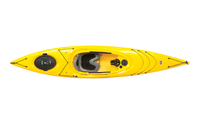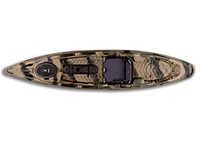How to Choose a Kayak
First-time paddlers sometimes feel head-spinningly confused when they’re trying to select an appropriate kayak for themselves. The diversity of shapes and sizes in the showroom is confusing enough, let alone all the vocabulary they may be wading through: touring kayak, recreational kayak, rocker, beam, skeg, etc.
Fortunately, familiarizing yourself with the basic characteristics of a kayak as well as the distinctive features of different types can be a pretty straightforward process. If you always keep in mind the type of paddling you ultimately want to do, you’ll usually be able to narrow down your options without much back-and-forth.
Here we’ll provide a general overview of kayak anatomy and categories to help with the selection process. Think of it as a general blueprint to orient yourself. If you have further questions, someone at Paddlers Cove will be more than happy to answer them!
Basic Kayak Features & Performance
You can find more detailed information on kayak design elsewhere on the site, but let’s quickly run through some of the more important features of the boat and how they impact performance and handling. The variations in kayak size and form tend to most prominently affect the boat’s speed, tracking (its ability to adhere to a straight-ahead course), turning, and stability.
Kayak length varies significantly, from 4-foot-long slalom whitewater kayaks to 20-foot-long sea kayaks. Longer kayaks tend to be swifter and track better than shorter kayaks, which are significantly easier to turn.
The beam of the kayak is its width. Wider boats are often slower and harder to paddle than narrow ones, but may feel more stable depending on conditions. Stability is divided into two types. Initial stability is the steadiness of the kayak when it’s sitting upright, as in calm water. Secondary stability refers to the stability of the boat when it’s leaning to one side or another. In general, a wide-beamed kayak typically has a lot of initial stability; a narrow-beamed one can feel unstable when you first slip inside. But the narrower kayak often has greater secondary stability: When rolled by waves or your own shifting weight, it doesn’t feel as if it’s about to capsize.
Also important when considering stability is the cross-sectional shape of the boat’s hull. A rounded hull has less initial stability and more secondary stability than a blocky, hard-angled hull. (You’ll run into the word chine in connection with hull cross-sections. Chine refers to the sharpness of the angle where the sides and bottom of the hull meet. A hard chine is a sharp-angled hull; more rounded hulls have a soft chine.)
Rocker describes the extent of slope between the keel of the kayak and the points of the bow and stern. A kayak with a lot of rocker has a significant sweep up from bottom to ends; such a boat is easier to turn. A kayak with little rocker has a keel that remains mostly level and barely curves to meet the bow or stern. That kind of boat won’t turn as easily, but will track more efficiently and slice along at a better clip.
There are certainly other important aspects to kayak design (not least the type of constructing material), but, now that we’re armed with a bit of insight into how boat size and shape help determine handling, we’ll proceed to surveying the different kinds of kayaks.

The kind you choose depends greatly on the environment you’re planning to paddle in—flatwater, open ocean, whitewater, etc.—and how long you intend most of your trips to be.
Recreational Kayaks
Recreational kayaks are some of the most popular models for all-around paddling. A kind of happy medium between more specialized types of ‘yaks, they’re easy to handle, stable, and versatile in terms of the settings they can successfully be used in. Beginner paddlers often select recreational kayaks to learn on, but experienced kayakers also commonly have them on hand as their go-to craft.
Basic & Performance Recreational Kayaks
Basic recreational kayaks are often 9 to 12 feet long and are wonderful boats for flatwater environments, from lakes to slow-moving rivers and estuaries. They tend to be fairly broad-beamed and quite stable, and usually offer enough storage space for an afternoon jaunt.
If you’re looking for a swifter boat with more capacity for longer trips, consider a performance recreational kayak. These can offer additional features such as skegs (which reinforce tracking) and rudders (for more precise steering) to support longer-distance paddling.
Tandem Kayaks
Tandem kayaks have two cockpits to accommodate a pair of paddlers—or more storage space. These are awesome boats for couples or parents with children. Along with single-piece tandems, modular kayaks with detachable sections make it easy to add on an additional cockpit. You can find tandems in both sit-inside and sit-on-top (see below) models.
Sit-on-Top Kayaks
Sit-on-top kayaks have exploded in popularity in recent decades as alternatives to the traditional sit-inside model. As the name suggests, you simply sit atop a sealed hull with these boats, which are easier to enter and exit than a sit-in. Because they don’t offer the protection from the elements that an enclosed cockpit and skirt do, sit-on-top kayaks are particularly suited to warm-water situations, though you can also use them in colder environments with the right layering.
Fishing Kayaks

Fishing Kayaks
An especially fast-growing sector of the paddling market is fishing kayaks. Anglers have discovered the incredible advantages a kayak provides for their pursuit: These quiet, highly maneuverable boats give them efficient access to a much broader range of fishing grounds.
Fishing kayaks come in many different designs these days. Sit-on-top kayaks are probably the most widely favored on account of their great stability, broad decks, and easy entry/exit setup. That’s not to say that sit-in kayaks don’t have a place in fishing, though: They’re great choices for extended or cold-season fishing treks, and offer extensive storage space for gear.

Sea/Touring Kayaks
Sea or touring kayaks are designed for use in big, open water, whether it’s a large lake or river or the open ocean. They’re unmistakable in form: long (upwards of 19 feet) and slender. Their length and narrowness mean they're fleet and beautifully efficient in holding course. Such qualities make them the kayak of choice for long-distance treks, especially those encompassing rough waters.
Day Touring Kayaks
For entry-level and intermediate paddlers, modest-sized day touring kayaks can be fantastic choices. They’re perfect for a day spent exploring bays and inlets, and can also be used for short trips.
Expedition Touring Kayaks
Serious paddlers might consider expedition touring kayaks, the elite of the sea-kayak family. These incredibly refined boats—which may be 20 feet long and just 19 inches across—have the speed, efficiency, and cargo space for multi-day adventures.
Whitewater Kayaks

Whitewater Kayaks
Radically different-looking than a sea kayak, the whitewater kayak is an equally specialized craft. These compact boats are made for the rough-and-tumble world of whitewater rivers and nearshore surf. They’re characteristically broad, stubby, and round-hulled, meaning they can be turned with exceptional ease and precision to negotiate boulders, driftwood, and other obstacles typical of swift-running currents.
All-Around Whitewater Kayaks
These are the most versatile whitewater ‘yaks, suitable for the broadest range of conditions and settings. You’ve got forgiving high-volume decks and performance-oriented hulls to keep you balanced and fully in control whether you’re running a river or surfing the whitecaps.
Playboats
As implied by their name, these short little ‘yaks are ideal for whitewater athletes who enjoy pulling off tricks, flips, and jumps in the rapids.
River/Creek Whitewater Kayaks
With a hull and high rocker designed for advanced maneuverability, these whitewater kayaks perform well in high water or challenging downriver conditions. Easy to roll, fast-turning, and boasting high initial stability, river/creek boats make for a great combination of performance and control.
